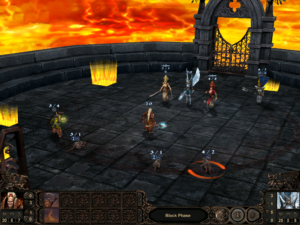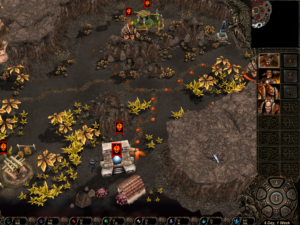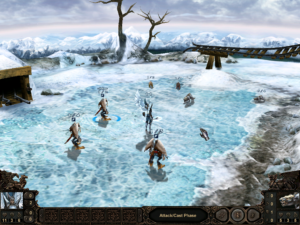Etherlords: Combos
Probably the biggest joy in CCG-style play is coming up with combos. By “combo”, I don’t mean the kind you get in, say, tile-matching games, where the rules explicitly grant bonuses for things that are not valuable in themselves. I mean emergent synergy, the special properties of different cards combining in a way that makes them more effective. This is the essence of deck construction.
For example, in Magic: the Gathering, there is a card called “Lure”. (Or at least, there was when I was playing it. A lot of cards were removed in subsequent revisions.) Lure is an enchantment that you cast on a creature. When a creature with Lure makes an attack, anything that can block it must do so. By itself, this would typically mean that the creature with Lure is met with overwhelming force and dies, but in the process, it lets your stronger attackers go unblocked for that turn, because blockers can only block one thing at a time. But if you put that Lure on a creature with Regeneration, it can survive the onslaught and play its part over and over, or at least until the opponent kills it with direct damage spells. Alternately, you can put it on a Thicket Basilisk, which has the special power that anything blocking it dies at the end of the combat round, and wipe out all the opponent’s creatures in one turn. Put all three cards (Lure, Regeneration, Thicket Basilisk) in your deck and you have a three-card combo with the potential to wipe out your opponent’s army every turn — but only if you happen to get them all in your hand and manage to cast both of the enchantments on the basilisk before the opponent kills it. With a minimum deck size of 40 cards, three-card combos can be hard to pull off.
The dynamic is a little different in Etherlords. For one thing, the 15-card deck size makes it almost certain that any combos you put in will come up. Also, some combos are more explicit than what I’ve just described. Each type of creature comes in multiple subtypes, with different levels of strength and different special abilities, and sometimes those special abilities are pretty clearly linked. Take the Kobold Elder: its power is to untap all Kobolds in play other than Kobold Elders. This is an ability that can only be used in combination with a rather small set of other cards. If you ask me, the only other kind of Kobold worth having in your hand is the Kobold Shaman, which is the Etherlords version of M:tG‘s Prodigal Sorcerer: you tap it to do 1 point of damage to any player or creature. Thus, if you have both in your deck, you get to do (number of Kobold Elders times number of Kobold Shamans) points of damage every turn, without even making an attack or casting any spells. This is potent. In one encounter late in map 4, I was routinely killing things with 8 or 9 health (that is, the hardiest creatures I had yet encountered) the moment they appeared.
Both of these effects — the smaller deck size and the signalling of likely combos through creature type — serve to make combos easier. The former makes them easier to execute, the latter makes them easier to discover. I can’t know if this was the result of a deliberate policy of combo-friendliness on the part of the designers or just a happy accident reinforced by playtesting, but that’s how it turned out. The downside, I suppose, is that it makes the combos seem very planned, and leaves little scope for the player to make genuinely new discoveries. But this is OK for a computer game with fixed content. Real CCGs take advantage of the combinatorial explosion to create an impression of infinitely variable gameplay. But campaign modes in strategy games are more about introducing you to gameplay elements one by one, and typically end when they run out of new things to show you. I expect that’s how it is here.
 Comments(6)
Comments(6)

